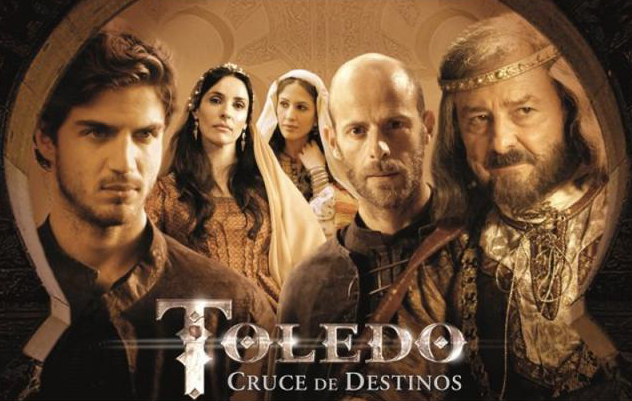Further to my post “Empty-headed Britons.” Of the television series I have been reviewing, I have found the first season of the Spanish-produced Toledo: Cruce de Destinos, premiered the last year, as the most offensive to date. It starts with a stunning scene in a Spanish garden of a wealthy family of whites in the 13th century. After some idyllic moments the family is attacked by the Moors with women, adolescents and children being assassinated in cold blood. One would expect that when the men return and see their families butchered the plot of the entire series would be revenge and expulsion of the Moors, right?
Nope! The whole series is an attempt to demonize the patriot Spaniards of such century, some of them real historical figures, that tried to expel the enemies by force. No kidding: that is exactly the ethos behind the script.
King Alfonso X of Castile is filmed as talking about “el sueño de la convivencia de las tres culturas” (“the dream of the coexistence between the three cultures”), meaning the Christian, the Muslim and the Jewish cultures as his ultimate dream for Castile. The series are perfectly Manichean: the hawks who crave for a war against the Moors and the Semites are absolutely evil; and the multicultural doves are the goods guys of the films. The first season actually ends with King Alfonso saying that his son Sancho, the hawk, is going into exile for life while the dove, his son Fernando, will inherit the crown to pursue his dream.
The whole series can be sketched thus:
• The Moors are revealed as the cruel invaders that they were in real history
• The Christian patriots who hate them are depicted as intolerant bigots throughout all episodes
• No single piece of mischief—nothing at all!—is ever committed by the Jews, who are always depicted as innocent doves
In a heated discussion in the first episode, the very one that depicts realistically the butchery of a white family, the Queen Violant of Aragon gives a speech to the main hawks of the story, the Archbishop of Toledo and the Count Miranda. The Queen says that Christians are supposed to turn the other cheek. Most surrealist of all is that the central character of these Spanish series, Rodrigo Pérez de Ayala whose eldest son and wife were among the victims of the butchery in first scene, sides the pacifist monarchs against the hawks!
Then Rodrigo returns to his home after not seeing for ten years what was left of his family. Who is the first guest to share Rodrigo’s table? Abraham Rubini, a Jew: his best friend throughout the series in fact. So much so that Rodrigo has a conversation with Abraham almost ignoring his surviving family who had been entranced to see that his father had finally came home after a decade…
The hawks Sancho and the Count Miranda are depicted as almost rapists or as rationalizing or excusing the rape of an innocent commoner girl. And—typical—the casting directors chose a very stunning actress to interpret the role of a Moorish woman: the one who speaks for the Muslim side (in the pic, sat at the front center).
In another scene, Abraham (extreme left in the pic) tells Rodrigo that Rodrigo’s role in the Castilian government must be “to defend the weak” of Toledo against the hawks. And in a discussion between Abraham and the Archbishop (standing at the right with his hands together) inside the royal court, the Christian is depicted as pig-headed and the Jew as wise. The richest Muslim of Toledo is also depicted as wise and concerned about the inexcusable intolerance of the Archbishop. It’s the Archbishop the one who incited a mob of fanatic Christians to attack the candid scholars working in Toledo’s school of translators, a school headed by Abraham. Afterwards there’s a scene where the hawk Sancho cowardly tries to stab the dove Fernando in the back, also in the royal court.
It is unnecessary continuing to recount more outrageous scenes, except adding that the series also contain typical scenes of soft-porn that have become so fashionable in recent TV series.
What alarms me is that Spaniards are largely clueless about what is happening to their media. Yes: it is true that in the blogosphere some Spanish critics have pointed out that the historical King Alfonso, also called The Wise, did not participate in such alliance of civilizations between Christians, Muslims and Jews, and that the series puts Toledo as a mainly Muslim city when really at the time they were a distinct minority in the city, surpassed even by the Jewish quarter. The TV story “invents a conspiracy of radical anti-Muslim Christians against King Alfonso, when in fact there was no such company.” But what made me laugh was a comment in “La serie Toledo” stating (my translation) that “the series could have been called ‘Zapatero in the country of the Alliance of Civilizations’.”
Even these critics don’t see the obvious: that patriot Christians have been painted with black; warrior Muslims with grey, and the Jews of Toledo with white! (In contrast to these fictional white doves, those interested to learn how the Jews behaved in historical Spain are advised to read the pertinent sections on the subject in Kevin MacDonald’s Separation and Its Discontents.)

